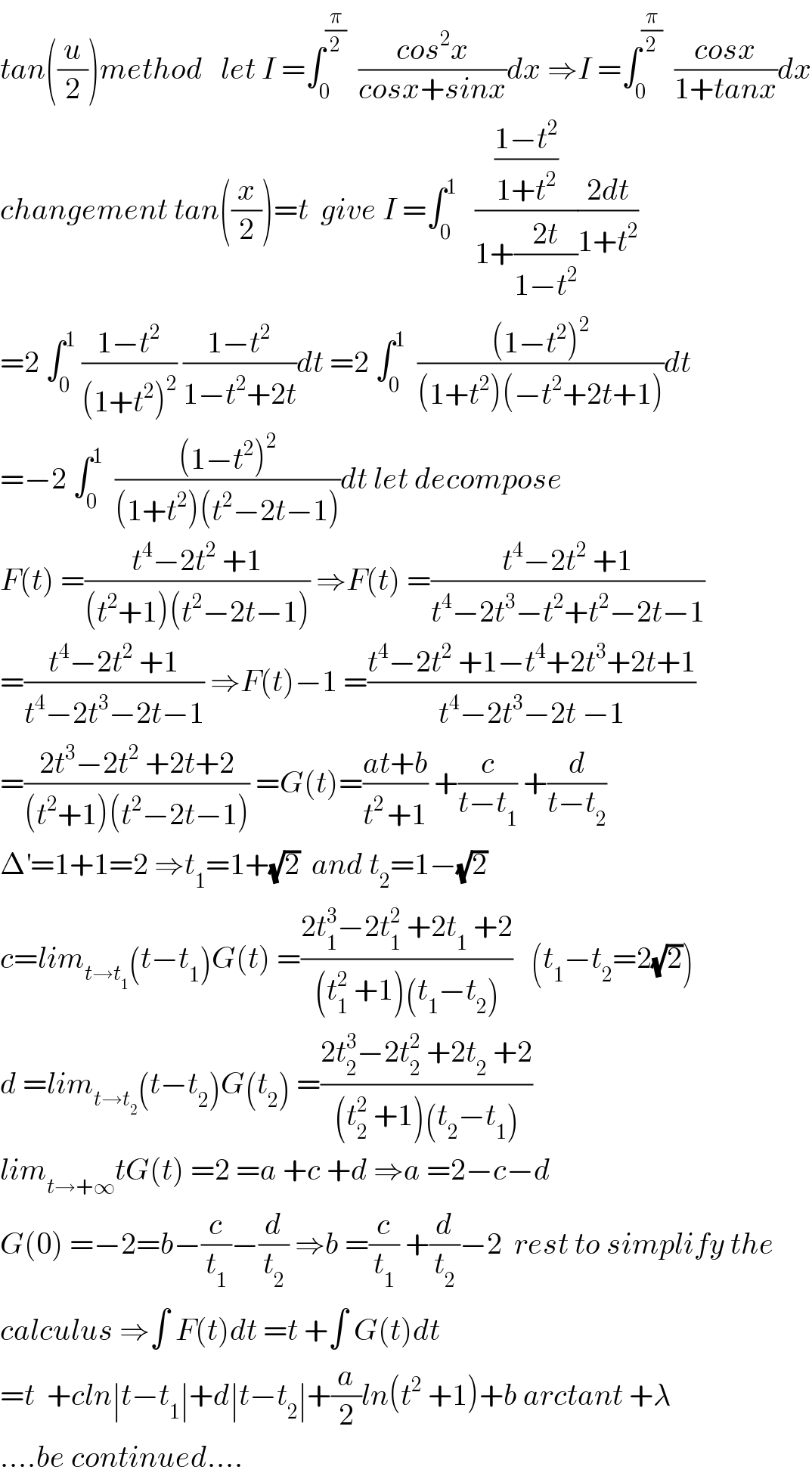
Question Number 65691 by mathmax by abdo last updated on 02/Aug/19

$${calculate}\:\int_{\mathrm{0}} ^{\frac{\pi}{\mathrm{2}}} \:\:\frac{{cos}^{\mathrm{2}} {x}}{{cosx}\:+{sinx}}{dx} \\ $$
Commented by mathmax by abdo last updated on 02/Aug/19

$${tan}\left(\frac{{u}}{\mathrm{2}}\right){method}\:\:\:{let}\:{I}\:=\int_{\mathrm{0}} ^{\frac{\pi}{\mathrm{2}}} \:\:\frac{{cos}^{\mathrm{2}} {x}}{{cosx}+{sinx}}{dx}\:\Rightarrow{I}\:=\int_{\mathrm{0}} ^{\frac{\pi}{\mathrm{2}}} \:\:\frac{{cosx}}{\mathrm{1}+{tanx}}{dx} \\ $$$${changement}\:{tan}\left(\frac{{x}}{\mathrm{2}}\right)={t}\:\:{give}\:{I}\:=\int_{\mathrm{0}} ^{\mathrm{1}} \:\:\:\frac{\frac{\mathrm{1}−{t}^{\mathrm{2}} }{\mathrm{1}+{t}^{\mathrm{2}} }}{\mathrm{1}+\frac{\mathrm{2}{t}}{\mathrm{1}−{t}^{\mathrm{2}} }}\frac{\mathrm{2}{dt}}{\mathrm{1}+{t}^{\mathrm{2}} } \\ $$$$=\mathrm{2}\:\int_{\mathrm{0}} ^{\mathrm{1}} \:\frac{\mathrm{1}−{t}^{\mathrm{2}} }{\left(\mathrm{1}+{t}^{\mathrm{2}} \right)^{\mathrm{2}} }\:\frac{\mathrm{1}−{t}^{\mathrm{2}} }{\mathrm{1}−{t}^{\mathrm{2}} +\mathrm{2}{t}}{dt}\:=\mathrm{2}\:\int_{\mathrm{0}} ^{\mathrm{1}} \:\:\frac{\left(\mathrm{1}−{t}^{\mathrm{2}} \right)^{\mathrm{2}} }{\left(\mathrm{1}+{t}^{\mathrm{2}} \right)\left(−{t}^{\mathrm{2}} +\mathrm{2}{t}+\mathrm{1}\right)}{dt} \\ $$$$=−\mathrm{2}\:\int_{\mathrm{0}} ^{\mathrm{1}} \:\:\frac{\left(\mathrm{1}−{t}^{\mathrm{2}} \right)^{\mathrm{2}} }{\left(\mathrm{1}+{t}^{\mathrm{2}} \right)\left({t}^{\mathrm{2}} −\mathrm{2}{t}−\mathrm{1}\right)}{dt}\:{let}\:{decompose}\: \\ $$$${F}\left({t}\right)\:=\frac{{t}^{\mathrm{4}} −\mathrm{2}{t}^{\mathrm{2}} \:+\mathrm{1}}{\left({t}^{\mathrm{2}} +\mathrm{1}\right)\left({t}^{\mathrm{2}} −\mathrm{2}{t}−\mathrm{1}\right)}\:\Rightarrow{F}\left({t}\right)\:=\frac{{t}^{\mathrm{4}} −\mathrm{2}{t}^{\mathrm{2}} \:+\mathrm{1}}{{t}^{\mathrm{4}} −\mathrm{2}{t}^{\mathrm{3}} −{t}^{\mathrm{2}} +{t}^{\mathrm{2}} −\mathrm{2}{t}−\mathrm{1}} \\ $$$$=\frac{{t}^{\mathrm{4}} −\mathrm{2}{t}^{\mathrm{2}} \:+\mathrm{1}}{{t}^{\mathrm{4}} −\mathrm{2}{t}^{\mathrm{3}} −\mathrm{2}{t}−\mathrm{1}}\:\Rightarrow{F}\left({t}\right)−\mathrm{1}\:=\frac{{t}^{\mathrm{4}} −\mathrm{2}{t}^{\mathrm{2}} \:+\mathrm{1}−{t}^{\mathrm{4}} +\mathrm{2}{t}^{\mathrm{3}} +\mathrm{2}{t}+\mathrm{1}}{{t}^{\mathrm{4}} −\mathrm{2}{t}^{\mathrm{3}} −\mathrm{2}{t}\:−\mathrm{1}} \\ $$$$=\frac{\mathrm{2}{t}^{\mathrm{3}} −\mathrm{2}{t}^{\mathrm{2}} \:+\mathrm{2}{t}+\mathrm{2}}{\left({t}^{\mathrm{2}} +\mathrm{1}\right)\left({t}^{\mathrm{2}} −\mathrm{2}{t}−\mathrm{1}\right)}\:={G}\left({t}\right)=\frac{{at}+{b}}{{t}^{\mathrm{2}\:} +\mathrm{1}}\:+\frac{{c}}{{t}−{t}_{\mathrm{1}} }\:+\frac{{d}}{{t}−{t}_{\mathrm{2}} } \\ $$$$\Delta^{'} =\mathrm{1}+\mathrm{1}=\mathrm{2}\:\Rightarrow{t}_{\mathrm{1}} =\mathrm{1}+\sqrt{\mathrm{2}}\:\:{and}\:{t}_{\mathrm{2}} =\mathrm{1}−\sqrt{\mathrm{2}} \\ $$$${c}={lim}_{{t}\rightarrow{t}_{\mathrm{1}} } \left({t}−{t}_{\mathrm{1}} \right){G}\left({t}\right)\:=\frac{\mathrm{2}{t}_{\mathrm{1}} ^{\mathrm{3}} −\mathrm{2}{t}_{\mathrm{1}} ^{\mathrm{2}} \:+\mathrm{2}{t}_{\mathrm{1}} \:+\mathrm{2}}{\left({t}_{\mathrm{1}} ^{\mathrm{2}} \:+\mathrm{1}\right)\left({t}_{\mathrm{1}} −{t}_{\mathrm{2}} \right)}\:\:\:\left({t}_{\mathrm{1}} −{t}_{\mathrm{2}} =\mathrm{2}\sqrt{\mathrm{2}}\right) \\ $$$${d}\:={lim}_{{t}\rightarrow{t}_{\mathrm{2}} } \left({t}−{t}_{\mathrm{2}} \right){G}\left({t}_{\mathrm{2}} \right)\:=\frac{\mathrm{2}{t}_{\mathrm{2}} ^{\mathrm{3}} −\mathrm{2}{t}_{\mathrm{2}} ^{\mathrm{2}} \:+\mathrm{2}{t}_{\mathrm{2}} \:+\mathrm{2}}{\left({t}_{\mathrm{2}} ^{\mathrm{2}} \:+\mathrm{1}\right)\left({t}_{\mathrm{2}} −{t}_{\mathrm{1}} \right)} \\ $$$${lim}_{{t}\rightarrow+\infty} {tG}\left({t}\right)\:=\mathrm{2}\:={a}\:+{c}\:+{d}\:\Rightarrow{a}\:=\mathrm{2}−{c}−{d} \\ $$$${G}\left(\mathrm{0}\right)\:=−\mathrm{2}={b}−\frac{{c}}{{t}_{\mathrm{1}} }−\frac{{d}}{{t}_{\mathrm{2}} }\:\Rightarrow{b}\:=\frac{{c}}{{t}_{\mathrm{1}} }\:+\frac{{d}}{{t}_{\mathrm{2}} }−\mathrm{2}\:\:{rest}\:{to}\:{simplify}\:{the} \\ $$$${calculus}\:\Rightarrow\int\:{F}\left({t}\right){dt}\:={t}\:+\int\:{G}\left({t}\right){dt} \\ $$$$={t}\:\:+{cln}\mid{t}−{t}_{\mathrm{1}} \mid+{d}\mid{t}−{t}_{\mathrm{2}} \mid+\frac{{a}}{\mathrm{2}}{ln}\left({t}^{\mathrm{2}} \:+\mathrm{1}\right)+{b}\:{arctant}\:+\lambda \\ $$$$....{be}\:{continued}.... \\ $$
Answered by Tanmay chaudhury last updated on 02/Aug/19
![I=∫_0 ^(π/2) ((cos^2 x)/(cosx+sinx))dx I=∫_0 ^(π/2) ((cos^2 ((π/2)−x))/(cos((π/2)−x)+sin((π/2)−x)))dx =∫_0 ^(π/2) ((sin^2 x)/(sinx+cosx))dx 2I=∫_0 ^(π/2) (dx/(sinx+cosx)) 2I=∫_0 ^(π/2) (dx/((√2) ((1/(√2))sinx+(1/(√2))cosx))) I=(1/(2(√2)))∫_0 ^(π/2) (dx/(sin((π/4)+x))) I=(1/(2(√2)))∫_0 ^(π/4) cosec((π/4)+x)dx I=(1/(2(√2)))∣lntan((((π/4)+x)/2))∣_0 ^(π/4) =(1/(2(√2)))[lntan((π/4))−lntan((π/8))] =((−1)/(2(√2)))lntan((π/8))](Q65718.png)
$${I}=\int_{\mathrm{0}} ^{\frac{\pi}{\mathrm{2}}} \frac{{cos}^{\mathrm{2}} {x}}{{cosx}+{sinx}}{dx} \\ $$$${I}=\int_{\mathrm{0}} ^{\frac{\pi}{\mathrm{2}}} \frac{{cos}^{\mathrm{2}} \left(\frac{\pi}{\mathrm{2}}−{x}\right)}{{cos}\left(\frac{\pi}{\mathrm{2}}−{x}\right)+{sin}\left(\frac{\pi}{\mathrm{2}}−{x}\right)}{dx} \\ $$$$=\int_{\mathrm{0}} ^{\frac{\pi}{\mathrm{2}}} \frac{{sin}^{\mathrm{2}} {x}}{{sinx}+{cosx}}{dx} \\ $$$$\mathrm{2}{I}=\int_{\mathrm{0}} ^{\frac{\pi}{\mathrm{2}}} \frac{{dx}}{{sinx}+{cosx}} \\ $$$$\mathrm{2}{I}=\int_{\mathrm{0}} ^{\frac{\pi}{\mathrm{2}}} \frac{{dx}}{\sqrt{\mathrm{2}}\:\left(\frac{\mathrm{1}}{\sqrt{\mathrm{2}}}{sinx}+\frac{\mathrm{1}}{\sqrt{\mathrm{2}}}{cosx}\right)} \\ $$$${I}=\frac{\mathrm{1}}{\mathrm{2}\sqrt{\mathrm{2}}}\int_{\mathrm{0}} ^{\frac{\pi}{\mathrm{2}}} \frac{{dx}}{{sin}\left(\frac{\pi}{\mathrm{4}}+{x}\right)} \\ $$$${I}=\frac{\mathrm{1}}{\mathrm{2}\sqrt{\mathrm{2}}}\int_{\mathrm{0}} ^{\frac{\pi}{\mathrm{4}}} {cosec}\left(\frac{\pi}{\mathrm{4}}+{x}\right){dx} \\ $$$${I}=\frac{\mathrm{1}}{\mathrm{2}\sqrt{\mathrm{2}}}\mid{lntan}\left(\frac{\frac{\pi}{\mathrm{4}}+{x}}{\mathrm{2}}\right)\mid_{\mathrm{0}} ^{\frac{\pi}{\mathrm{4}}} \\ $$$$=\frac{\mathrm{1}}{\mathrm{2}\sqrt{\mathrm{2}}}\left[{lntan}\left(\frac{\pi}{\mathrm{4}}\right)−{lntan}\left(\frac{\pi}{\mathrm{8}}\right)\right] \\ $$$$=\frac{−\mathrm{1}}{\mathrm{2}\sqrt{\mathrm{2}}}{lntan}\left(\frac{\pi}{\mathrm{8}}\right) \\ $$
Commented by mathmax by abdo last updated on 02/Aug/19

$${thank}\:{you}\:{sir}\:{tanmay} \\ $$
Commented by Tanmay chaudhury last updated on 02/Aug/19

$${most}\:{eelcome}\:{sir}... \\ $$
Commented by peter frank last updated on 02/Aug/19

$${thank}\:{you} \\ $$
